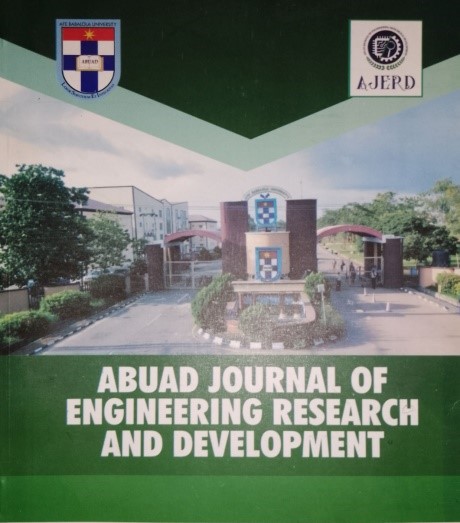Design and Fabrication of a Locally Made Plastic Shredder
Main Article Content
Abstract
Plastic waste management is a growing environmental concern due to the increasing production and disposal of plastic materials, which contribute to pollution and ecological degradation. Conventional plastic shredders are often expensive and inaccessible to small-scale recyclers, necessitating the development of cost-effective and locally fabricated alternatives. The project focuses on designing and fabricating a locally made plastic shredder that addresses plastic waste management challenges. The methodology involved a series of steps including needs assessment, literature review, conceptual and detailed design, material selection, fabrication, assembly, testing, and optimization. The shredder was designed to be cost-effective and efficient, utilizing locally available materials and expertise. Materials used included Aluminium and steel alloys for the frame, copper wire for the motor, high-quality bearings, rubber seals, and various electrical components. Tools employed in the fabrication process ranged from hand tools and power tools to welding equipment and testing instruments. Safety gear was also emphasized to protect workers during the fabrication and operation processes. The testing phase covered functional testing, load testing, efficiency testing, safety assessments, durability testing, environmental testing, and quality control inspections. Design calculations focused on parameters such as shredding capacity, torque, shear force, blade design, hopper volume, material feed rate, structural integrity, energy consumption, and shredder efficiency. Results indicated that the locally made plastic shredder effectively shredded various types of plastic waste, with a satisfactory shredding capacity of 0.21 kg/hr and a shredder efficiency of 83.12%. The torque transmitted by the shaft was 62.50 Nm, and the shear force required to cut through plastic was 2843.5 N. The blade speed was calculated at 41.89 rads/sec, with a cutting speed of 4189 m/sec. The energy consumption of the shredder was 4.48 Kwh. The project concluded that locally made plastic shredders could significantly contribute to sustainable plastic waste management, resource conservation, and environmental protection.
Downloads
Article Details

This work is licensed under a Creative Commons Attribution-NonCommercial-ShareAlike 4.0 International License.
References
Achmad, R., Wardani, B., Martana, S., & Prayitno, S. (2023). Rancang Bangun Mesin Pencacah Plastik Berjenis Multilayer Dengan Model Pisau Shredder. Journal of Sustainable Mechanical Engineering. https://doi.org/10.54378/josme.v1i1.6193
Barnes, D. K., Galgani, F., Thompson, R. C., & Barlaz, M. (2009). Accumulation and Fragmentation of Plastic Debris in Global Environments. Philosophical Transactions of the Royal Society B: Biological Sciences, 364(1526), 1985–1998. https://doi.org/10.1098/rstb.2008.0205
Callister, W. D., & Rethwisch, D. G. (2024). Materials Science and Engineering: An Introduction (10th ed.). Wiley.
Clark, J. R., Smith, A. B., & Garcia, C. (2022). Plastic waste reduction strategies: A review of current practices and prospects. Environmental Science and Technology, 55(3), 1475–1491.
Eriksen, M., Lebreton, L. C., Carson, H. S., Thiel, M., Moore, C. J., Borerro, J. C., Galgani, F., Ryan, P. G., & Reisser, J. (2014). Plastic Pollution in the World's Oceans: More than 5 Trillion Plastic Pieces Weighing over 250,000 Tons Afloat at Sea. PLOS ONE, 9(12), e111913. https://doi.org/10.1371/journal.pone.0111913
Gareth, S., & Parkinson. (2023). Design and Fabrication of Plastic Shredder. International Journal for Science Technology and Engineering. https://doi.org/10.22214/ijraset.2023.53653
Geyer, R., Jambeck, J. R., & Law, K. L. (2017). Production, Use, and Fate of All Plastics Ever Made. Science Advances, 3(7), e1700782. https://doi.org/10.1126/sciadv.1700782
Jambeck, J. R., Geyer, R., Wilcox, C., Siegler, T. R., Perryman, M., Andrady, A., Narayan, R., & Law, K. L. (2015). Plastic Waste Inputs from Land into the Ocean. Science, 347(6223), 768–771. https://doi.org/10.1126/science.1260352
José-M., Tejero-Olalla., M., Carmen, Muñoz., Óscar, D., de-Cózar-Macías., José, Macías-García., Laia, Miravet-Garret., Fernando, Gómez-Hermosa. (2024). Promoting Circular Economy Around Plastic Waste: A New Design of Recycled Plastic Shredder. https://doi.org/10.1007/978-3-031-51623-8_67
Kumar, S., Nair, S. R., Singh, N. K., Singh, S. P., & Arya, S. (2019). Recycling of Plastics in Indian Perspective: From Waste Disposal to Resource Recovery. Journal of Environmental Management, 233, 45–53. https://doi.org/10.1016/j.jenvman.2018.11.079
McKurai, M., Christopher, B., & Aezeden, M. (2024). Design of Innovative and User‐Friendly Household PET Plastic Bottle Shredder to Promote Green Economy. https://doi.org/10.1002/9781394198221.ch6
Minig, M., Bubuwau, C., & Mohamed, A. (2024). Design of Innovative and User‐Friendly Household PET Plastic Bottle Shredder to Promote Green Economy. 71–79. https://doi.org/10.1002/9781394198221.ch6
Olodu, D. D., & Akokhia, S. P. (2022). Design and Construction of an Automated and Manual New-Fangled Fruit Juice Extractor. International Journal of Engineering and Innovative Research, 4(1), 10–22. https://doi.org/10.47933/ijeir.1013688
Parkinson, G. S. (2023). Design and Fabrication of Plastic Shredder. International Journal For Science Technology And Engineering, 11(6), 181–187. https://doi.org/10.22214/ijraset.2023.53653
Patil, V. (2023). Design and Fabrication of Plastic Shredding Machine. International Journal For Science Technology And Engineering, 11(4), 1070–1077. https://doi.org/10.22214/ijraset.2023.50286
Reddy, S., & Raju, T. (2018). Design and Development of Mini Plastic Shredder Machine. ICAAMM, IOP Conference Series: Materials Science and Engineering, 455, 012119. https://doi.org/10.1088/1757-899X/455/1/012119
Rochman, C. M., Browne, M. A., Underwood, A. J., Van Franeker, J. A., Thompson, R. C., & Amaral-Zettler, L. A. (2013). The Ecological Impacts of Marine Debris: Unraveling the Demonstrated Evidence from What Is Perceived. Ecology, 97(2), 302–312. https://doi.org/10.1890/14-2070.1
Schmidt, C., Krauth, T., & Wagner, S. (2017). Export of Plastic Debris by Rivers into the Sea. Environmental Science & Technology, 51(21), 12246–12253. https://doi.org/10.1021/acs.est.7b02368
Sudhakara, R. & Raju, T. (2018). Design and Development of Mini Plastic Shredder Machine. ICAAMM, IOP Conference Series: Materials Science and Engineering, 455, 012119. https://doi.org/10.1088/1757-899X/455/1/012119
Surgude, P. A., Sawant, A. R., Nirwan, T. A., Vhatkar, P. R., & Modak, G. S. (2023). Design and Fabrication of Plastic Shredder. International Journal for Research in Applied Science & Engineering Technology (IJRASET), 11(6), 181.
Tejero-Olalla, J.-M., Muñoz, M. C., de-Cózar-Macías, Ó. D., Macías-García, J., Miravet-Garret, L., & Gómez-Hermosa, F. (2024). Promoting Circular Economy Around Plastic Waste: A New Design of Recycled Plastic Shredder (pp. 679–690). Springer Nature. https://doi.org/10.1007/978-3-031-51623-8_67
Thompson, R. C., Moore, C. J., Saal, F. S., & Swan, S. H. (2009). Plastics, the Environment, and Human Health: Current Consensus and Future Trends. Philosophical Transactions of the Royal Society B: Biological Sciences, 364(1526), 2153–2166. https://doi.org/10.1098/rstb.2009.0053
Vaishnavi, P. (2023). Design and Fabrication of Plastic Shredding Machine. International Journal For Science Technology And Engineering. https://doi.org/10.22214/ijraset.2023.50286




